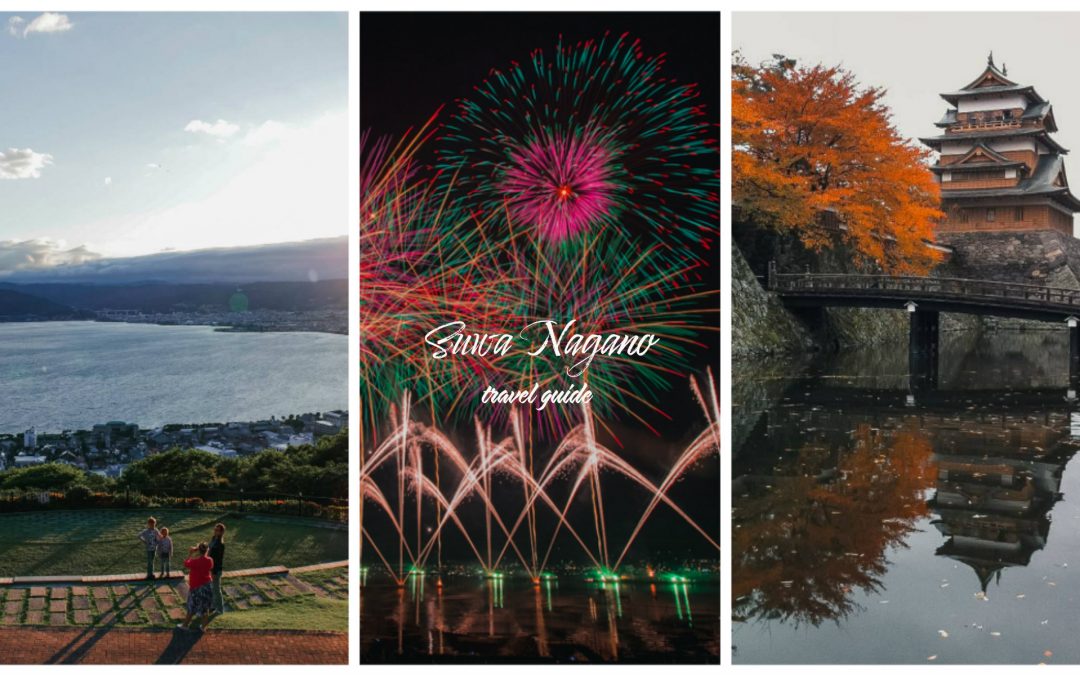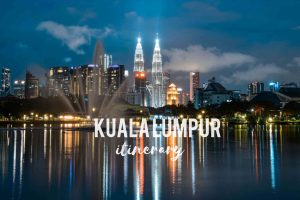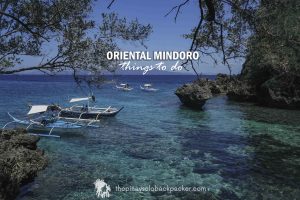Suwa, Nagano is an underrated beauty. This is a place with a history and mythology just as dramatic as its scenery. I felt the change of pace as soon as I arrived here. Suwa has this tranquil atmosphere, the city is brimming with temples, forest-fringed mountains, and a massive lake in the heart of the city that’s perfect for a laidback stroll. Indeed, it feels like a place where the gods reside.
In the book “The Esoteric Codez: Demons and Deities of Wind and Sky” by Rocco Granvil, it is mentioned that local legends speak of a certain god who arrived and resided in Suwa, only to face resistance from local deities. One of them is Moreya, armed with a kagi (iron weapon), challenged the foreign newcomer armed with a wisteria vine but ended up being defeated. The outsider then became Suwa-myojin, the chief god of the region. A common name for the gods enshrined in Suwa Taisha Shrine since the middle ages is Suwa-myojin or Suwa-daimyojin.
Suwa city was developed as a castle town under the Tokugawa shogunate during the Edo period. Kamisuwa village (former name of Suwa) was established during the post-Meiji restoration, eventually merging with Shiga and Toyoda to form the current city – Suwa.
I was lucky enough to explore Suwa during our Nagano trip. If you never visited before, I have prepared a Suwa travel guide with itinerary and sample budget below to help you.
TRAVEL BLOG CONTENTS
SUWA TRAVEL GUIDE
BEST TIME TO VISIT SUWA, NAGANO
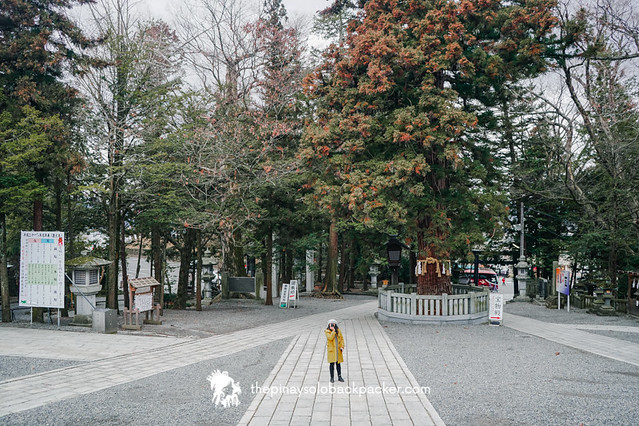
Suwa has hot and humid summers and generally mild winter. Best time to go to Suwa, Nagano is during the fireworks festival held every August 15, and also, during winter, spring, and autumn.
JAPAN VISA: Most residents of Southeast Asian countries including Filipinos need a visa to enter Japan. If you are a Philippine Passport holder, you can read my detailed Japan Visa Guide HERE
WI-FI: I usually use a pocket Wi-Fi during my stay in Japan. It is good for up to 5 devices at once. It was pretty reliable, you can pick it up at the airport upon your arrival.
ELECTRICITY: Suwa uses 2 electric plugs, Type A and Type B. If you’re from the Philippines, we use the same type of power plug, so I didn’t need to use my travel adapter. For other nationalities, best to bring a travel adapter. Japan standard voltage is 100 V and 50 HZ.
CURRENCY AND ATMS IN SUWA, NAGANO: Like the rest of Japan, Japanese Yen (¥) is used. Cash is widely accepted especially by small establishments. Stack up cash (¥) when visiting. But in case you need to withdraw, there are ATMs sprinkled in Suwa, Nagano. I suggest using 7-Eleven ATMs because they are good for international cards.
HOW TO GET TO SUWA CITY
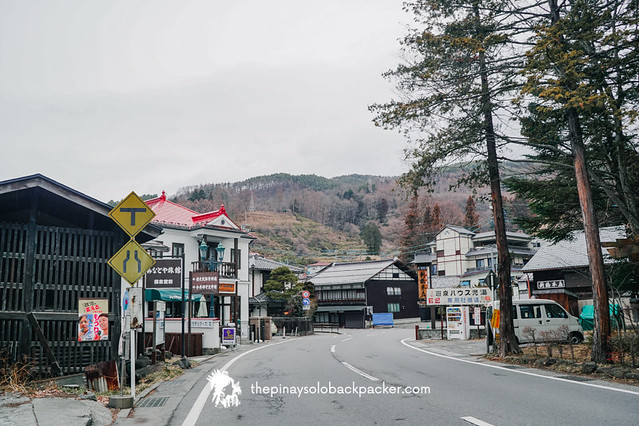
BY AIR
INTERNATIONAL AIRPORT ACCESS
If you’re coming from the Philippines or other South East Asian Countries, there’s no direct flight to Suwa or any of the major cities in Nagano. You have to fly either to Tokyo (and make your way to Shinjuku Station) or Nagoya.
So here are your options:
FROM TOKYO
Haneda International Airport -> Shinjuku Station -> (then see Tokyo to Suwa by train below)
1.Keikyu-Kuko Line to Shinagawa
2.Transfer to Yamanote Line from Shinagawa to Shinjuku
Fare: ¥610 (₱286 – $5.51 – SGD 8 – MYR 23)
Travel time: Approximately 70 mins
Narita International Airport -> Shinjuku Station -> (then see Tokyo to Suwa by train below)
- Keisei Skyliner or JR Narita Express to Nippori
- From Nippori transfer to Yamanote Line to Shinjuku
Fare: ¥1,230 (₱577 – $11 – SGD 15 – MYR 46) to ¥3,190 (₱1,497 – $28 – SGD 39 – MYR 120)
Travel time: Approximately 91 mins – 112 mins
FROM NAGOYA
Chubu International Airport -> To Nagoya (then see Nagoya to Suwa by train below)
1.From Centrair Japan International Airport take Meitetsu Mu – SKY Limited Express train towards Meitetsu Nagoya
Fare: ¥1,230 (₱577 – $11 – SGD 15 – MYR 46 )
Travel time: Approximately 33 mins – 44 mins
DOMESTIC AIRPORT ACCESS (VIA MATSUMOTO)

Shinshu Matsumoto Airport in Nagano serves domestic flights, there are 3 airports in Japan connected to it:
FROM FUKUOKA: Flight time 110 mins.
FROM SAPPORO: Flight time 90 mins
FROM OSAKA: Flight time 60 mins.
BY TRAIN

Suwa City is located on the JR Chuo Line, providing easy access from Tokyo, Osaka, and Nagoya.
TOKYO TO SUWA (LAKE SUWA)
- From Shinjuku Station (JR Line) in Tokyo, take the Limited Express Azusa to Kami-Suwa Station.
- Get off at Kami-Suwa Station, and take Suwako Exit (West).
Fare: ¥5,870 (₱ 2,758 – $53 – SGD 72 – MYR 221)
Travel Time: Approximately 2.5 hours
NAGOYA TO SUWA, NAGANO
- From Nagoya Station, take a Limited Express Shinano
- Alight at Shinano.
- Transfer to Limited Express Azusa.
- Get off at Kami-suwa Station.
Fare: ¥7,260 (₱ 3,408 – $65 – SGD 90 – MYR 274 )
Travel Time: Approximately 189 mins – 219 mins
OSAKA TO SUWA, NAGANO
1.From Shin-Osaka Station, take a shinkansen to Nagoya.
2.Transfer to Limited Express Shinano
3.Alight at Shinano.
4.Transfer to Limited Express Azusa.
5.Get off at Kami-Suwa Station.
Fare: Starts at ¥11,030 (₱ 5,777 – $100 – SGD 136 – MYR 415)
Travel Time: Approximately 210 mins – 216 mins
BY BUS
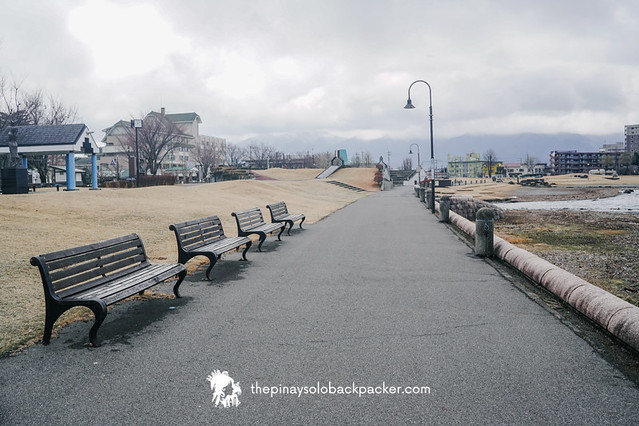
If you are on a tight budget, a cheaper option is traveling to Suwa by bus, but take note that this will take longer.
FROM TOKYO: Shinjuku ▸ Chino, Kami-Suwa, Shimo-Suwa, or Okaya Stations, Express bus
Travel time: 3 – 4hrs
FROM OSAKA: Osaka (Umeda) ▸ Okaya, Kami-Suwa or Chino Stations, Express bus
Travel time: 6 – 9 hours
GETTING AROUND SUWA
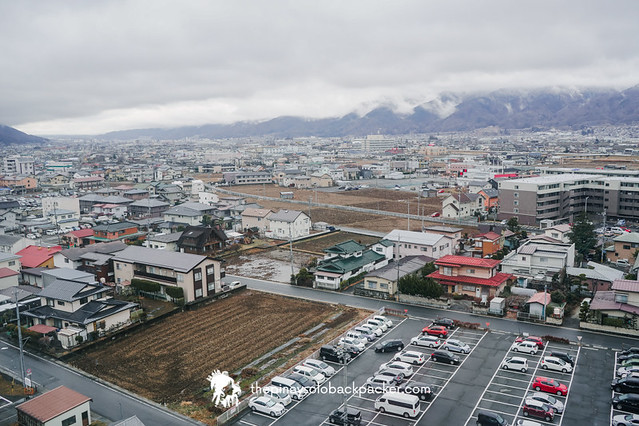
BY TRAIN
Train is the best way to go around the massive Lake Suwa. The stations that you’ll most likely use during your Lake Suwa trip are : Kami-Suwa Station, Shimo-Suwa Station, JR Chino Station, and Okaya Station.
Fare starts from ¥190 (₱89- $1.72 – SGD 2.35 – MYR 7 ) – ¥200 (₱ 94 – $1.8 – SGD 2.48 – MYR 8 ), but if you have a JR Rail Pass, most of them are covered (the JR Lines and Limited Express Azusa).
BY BUS
There’s a Swan Bus in Suwa that goes to Suwa Garasu No Sato, fare is ¥150 (₱70- $1.35 – SGD 2 – MYR 6 ) for adults and ¥80 (₱80- $0.72 – SGD 0.99 – MYR 3) for children. They also offer a 1 Day ticket that entitle holders 1-day unlimited rides for ¥300 (₱141 – $3 – SGD 4 – MYR 11 ) and ¥150 (₱70- $1.35 – SGD 2 – MYR 6 ) for children. When planning your itinerary, check the bus timetable HERE.
If you plan to get to the Kita-Yatsugatake Ropeway, there’s also a bus that goes there from Chino Station. See the timetable through the link I mentioned above. There’s also a Tateshina Kogen Round Bus that goes to some tourist spots in Suwa, including Lake Tateshina and Shokoji Temple.
WHERE TO STAY IN SUWA CITY, NAGANO
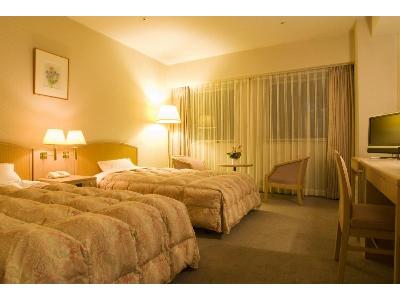
There are several hotels in Suwa City, but it’s best to find one that’s near Lake Suwa. We stayed at Rako Hananoi Resort Hotel, I like this hotel because of the service of their staff. They also have several onsen (hot spring). Abi and I got to try the private onsen, since I’m not comfortable using the public onsen. Been to Japan several times but this is actually the first time for me to try the onsen in Japan and I enjoyed the experience.

Rako Hananoi Resort Hotel has spacious, clean rooms, and my bed was comfortable. They even have rooms with the scenic view of Lake Suwa where you can watch the fireworks. You can also view Lake Suwa while eating breakfast at one of their dining areas. And if you want a traditional Japanese dining, they also have a Japanese Restaurant that’s so Zen. We got to try their kaiseki-style dinner with their super good sukiyaki. Don’t miss it when staying at this hotel.
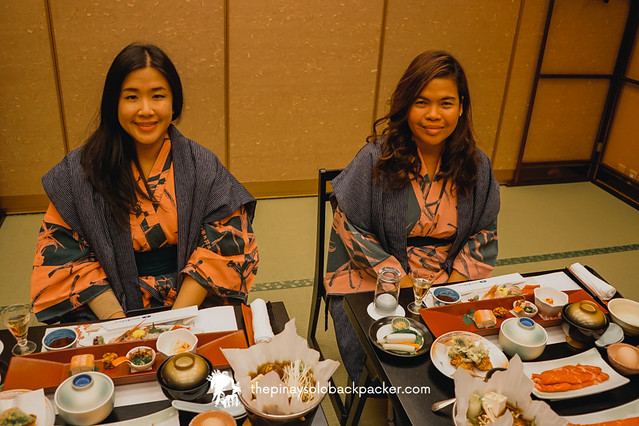
RAKO HANANOI RESORT HOTEL
Location: 2-1200 Takashima Suwa-City Nagano
Tel: +81 266-54-0333
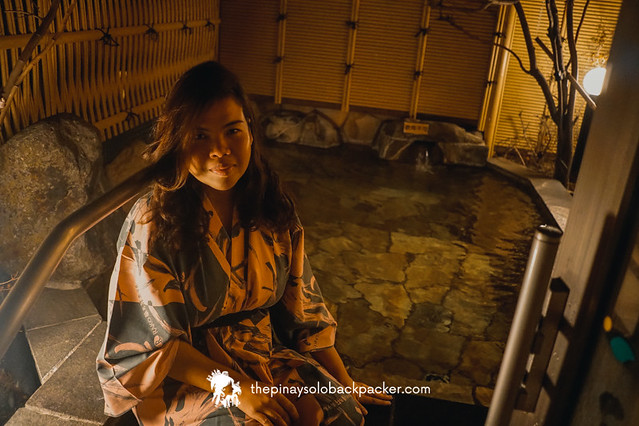
at the private onsen
SUWA TOP THINGS TO DO AND TOURIST ATTRACTIONS
There are many activities and tourist attractions in Suwa, Nagano that you can visit and try. Here’s my handpicked list (not in order).
1.SUWA TAISHA

Suwa Taisha Shrine is one of the oldest and one of the most important Shinto Shrines in Japan composed of 4 shrines. It is believed to have been founded over 1,200 years ago. It is the head shrine of over 10,000 Suwa sub-shrines all over the country. Suwa Taisha Shrine is actually a shrine complex consisting of 4 main shrines located at 2 sites separated by Lake Suwa – the Shimosha (Lower Shrine) composed of Akimiya (Autumn Shrine) and Harumiya (Spring Shrine) is situated on the northern side of the lake in Shimosuwa while the Kamisha (Upper Shrine) composed of Maemiya (Former Shrine) and Honmiya (Main Shrine) is on the southern part of the lake in Chino City and Suwa City. Also sprinkled around the lake are ancillary shrines.
Suwa Taisha is mentioned in Japan’s oldest surviving historical journal – the Kojiki (Records of Ancient Matters). The kami (deity) of the Upper Shrine is Takeminakata (also called Takeminakata-no-kami or Minakatatomi) while the lower shrine’s divine being is Yasakatome. Both are Misahguji, local agriculture and fertilities gods. Scholars believe that Takeminakata is originally a water deity,and/or a connection to Lake Suwa.

We visited the Main Shrine – the Upper Shrine Kamisha Honmiya. I remember arriving in this place while some cute kids are visiting the temples too. They were giddily playing around. I find the atmosphere of the place balmy and relaxing, fringed by wilderness. This is a place with a history just as dramatic as its scenery. Just outside the temple complex the downhill road has a scenic view of the surroundings, and I was told that when the sky is clear, you can even see Mt.Fuji from there.

The Onbashira Festival (The Great Pillar Festival), held every 6 years in the Monkey and Tiger years of the Chinese Lunar Calendar, serve as a symbolic renewal of the shrine buildings that has 4 huge fir trees standing on each corner or the “setting up a new pillar in life”. During the festival, 16 carefully selected fir trees are cut down and dragged from the mountain where festival goers ride the logs as they are slid down the mountain. This process is known as Yamadashi. It is dubbed as one of the most dangerous festivals in Japan due to some deaths and injuries over the years. The 16 pillars (hashira) are then erected at the 4 shrines, 4 on each corner. This activity is known as Satobiki. I really hope to attend the next festival in 2022.
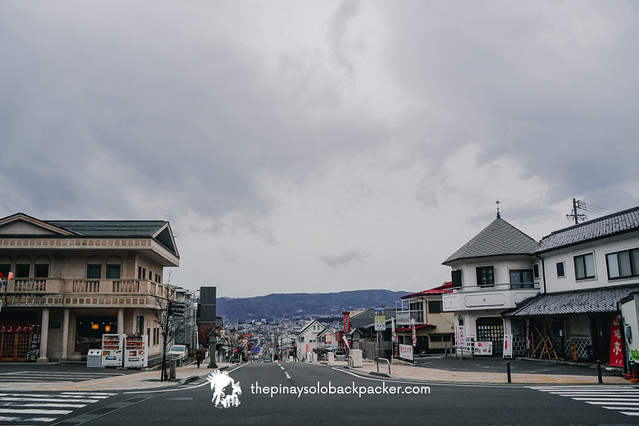
For anime fans, in the Rurouni Kenshin anime, Suwa Taisha Shrine at Lake Suwa was mentioned as the location of the divine elixir that may possibly cure any illness. The Black Knights wanted to acquire the divine elixir to dominate the world, so they approach a priest who told them of Suwa Taisha Shrine’s history. But the Sanada Ninjas attacked them.
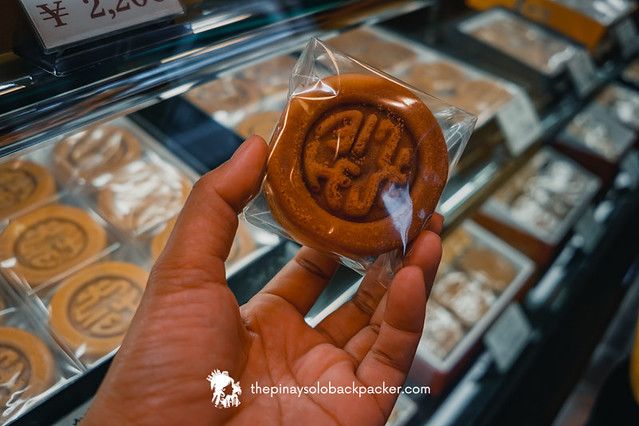
TIP: Nearby the shrine, there are shops selling local goodies that are really good.
Suwa Taisha Shrine
Location: Suwa City + Shimo-Suwa + Chino City
Open Hours: 24/7
Entrance Fee: FREE
How to get to Suwa Taisha Shrine:
Kamisha Maemiya (Upper Shrine): From JR Chino Station, take the Suwa bus bound for Okuma and get off at Maemiya-mae bus stop (about 7 minutes).
Kamisha Honmiya (Upper Shrine): 15 minutes by taxi from JR Chino Station
Shimosha Harumiya (Lower Shrine): 15 minute-walk from JR Shimo-Suwa Station
Shimosha Akimiya (Lower Shrine): 10 minute-walk from JR Shimo-Suwa Station
2. LAKE SUWA
The massive Lake Suwa, locally known as Suwako, sitting at the heart of Suwa in Nagano Prefecture is the largest lake in Shinsu. I wish I stayed longer here, because I really like the ambiance of this destination and the breeze touching my face while enjoying the scenic view of the lake. It’s a tranquil place for a relaxing walk, biking, or simply sitting on one of the benches here.

There are many water activities at Lake Suwa depending on the season you are visiting. During summer, you can enjoy a relaxing swan boat tour at Lake Suwa. Don’t miss the Lake Suwa Fireworks Festival – one of Japan’s largest fireworks festival happening every August 15. During this event, the lake is illuminated by over 40,000 fireworks for 2 hours.

Lake Suwa Fireworks Festival (photo provided by Nagano Tourism)
In spring, Lake Suwa, which is fringed by cherry blossoms tree is a beautiful sight.
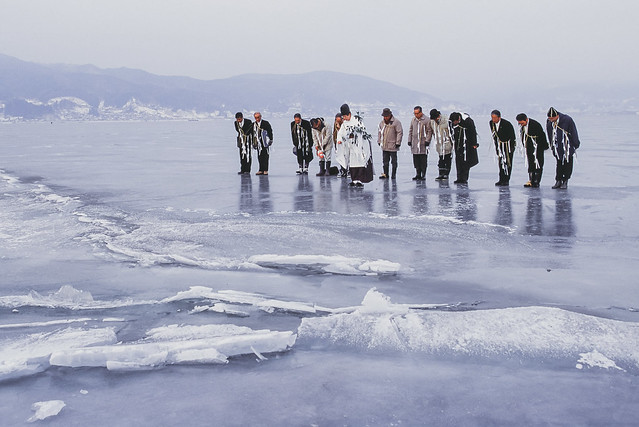
O-miwatari at lake Suwa (photo provided by Nagano Tourism)
During winter, the place is best known for a natural phenomenon forming ice ridges on the surface of the lake called “O-miwatari” or “The God’s Crossing”. This process happens when the lake is completely frozen and the ice melt due to the rising temperature during the day and at night the temperature drops causing the lake’s surface to shrink and create the ridges and cracks. Reportedly, there are also natural hot springs below the lake.
Interestingly, in the ancient Shinto Religion, the locals believe that during this phenomenon, that Takeminakata, the god of the Upper Shrine of Suwa Taisha descends to the lake to see Yasakatome, the deity of the Lower Shrine. The Shinto Ritual of the O-miwatari (The God’s Crossing) has long been an important part of the religion as it is believed to be a good omen, used to tell the fortunes of the crops, weather, etc. Unfortunately, due to global warming, this has now become a rare occurrence.
For anime fans, Lake Suwa is the location that inspired the lake and scenery of Imotori town, home of Mitsuha Miyamizu, in the Kimi no Nawa anime film.
Lake Suwa
Location: Suwa, Nagano
Entrance Fee: FREE
Open Hours: 24/7
How to get to Lake Suwa:
1.From Shinjuku Station (JR Line) in Tokyo, take the Limited Express Azusa to Kami-Suwa Station. Fare is around ¥5,870 (₱ 2,758 – $53) and travel time is approximately 2.5 hours.
2.Get off at Kami-Suwa Station, and take Suwako Exit (West).
3. Walk to Lake Suwa for about 8 minutes.
3.SUWA ICE CREAM
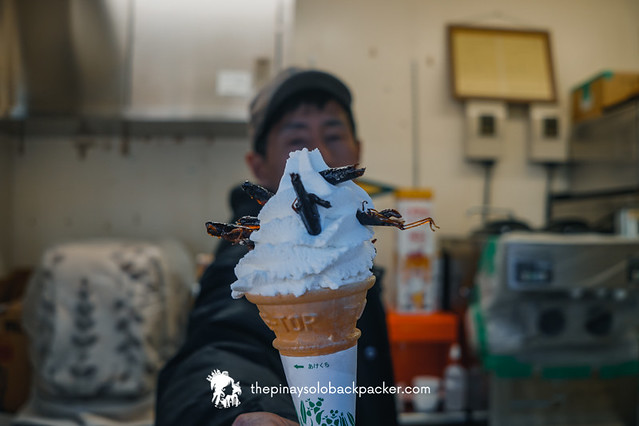
While you are at Lake Suwa, don’t miss trying their soft ice cream, especially their cricket ice cream! It looks scary at first look, but I find it deliciously good! The sweet milky ice cream blends well with the dried salty cricket on top. The cricket ice cream at Lake Suwa costs ¥450 (₱211- $4).
4.SUWA UNAGI
Lake Suwa is not just a place for a leisurely walk, this tourist destination in Suwa is also a perfect place for a food trip since the lake is sprinkled with a variety of restaurants serving soba noodles, ramen, unagi, etc. During our visit, we tried the famous grilled unagidon (grilled eel on rice) at Tenryuu, nearby Lake Suwa, a pretty famous old-fashioned restaurant for unagi.

Unagi is the Japanese word for eel, and it is a local delicacy of Nagano. What makes Nagano’s unagi special is that the preparation is quite different from the usual unagi served at other prefectures in Japan. The usual preparation of unagi involves steaming the eel first before grilling. In Nagano, the unagi is prepared by opening and cutting the belly then grilling it over the charcoal so the skin is crispy. Unagidon is on the pricier side, but its irresistible taste makes up for its expensive price.

Tenryuu (天龍)
Location: 3 Chome-22-11 Tenryucho Okaya-shi Nagano-ken
Open Hours: 11:30 AM – 2:00 PM and 5:30 PM – 8:00 PM daily
Price: starts at ¥3,000 (₱ 1,409 – $27 – SGD 37 – MYR 113)
How to get to Teryuu Unagi Restaurant: About an 11-minute walk from Okaya Station along the Tenryu River across the Shimonohama Kumin Center. Also a few meters away from Lake Suwa, use Google Maps, put 天龍 as destination. CLICK HERE for directions.
TIP: You can also visit the nearby Okayahokan Park.
5.SUWA GARASU NO SATO
On the southern side of Lake Suwa lies a famed Glass Museum in Japan – the Suwa Garasu No Sato. Some exhibits are temporary, but others are permanent exhibits. One distinct exhibit here is the Gigantic Marble, a massive glass ball that is on sale for ¥200M (₱ 9.4 M – $1.8M)!
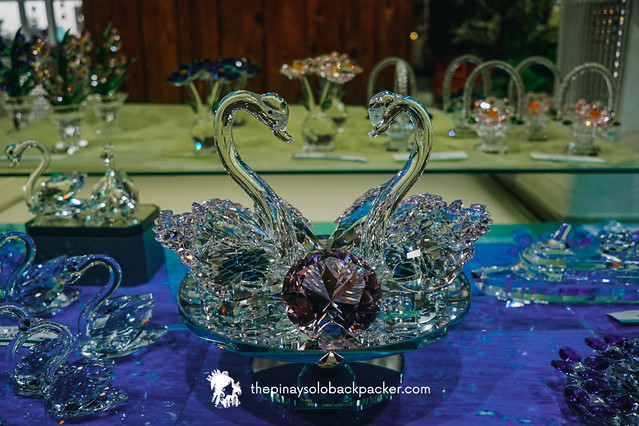
The Suwa Garaso No Sato also features a glass shop with over 20,000 glass pieces. This place sells all kinds of glassware including lamps, candles, jewelries, kaleidoscope, picture frames, etc. I bought some kaleidoscopes again, like the ones we made at Zenkoji Temple. They also sell a variety of Japanese local goodies and food here.

But what I really like about this place is the workshop they offer at the Glass Experience Studio for candle-making, dragonfly ball-making, paperweights, seals, etc. We joined a candle-making course here, and it’s not the ordinary candle-making we know, but it’s a candle made of gel wax and glass miniatures from animals to plants, trees, flowers, etc. The price of each piece starts at ¥300 (₱ 140 – $3), so how expensive your candle is will depend on the pieces that you’ll choose.
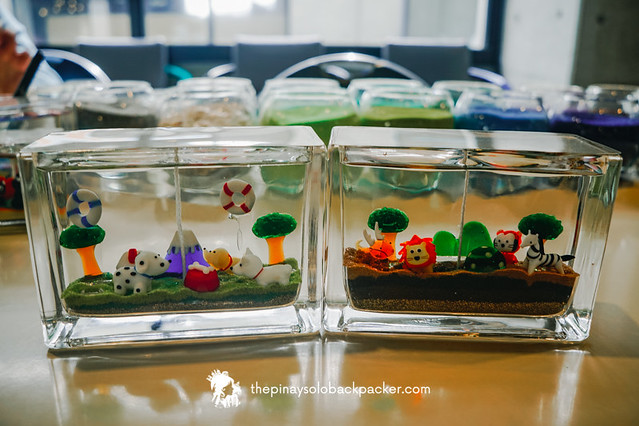
our finished product – glass candles
First, we were asked to imagine a design that we want for our candles. Then we were told to pick the candle style that we want – round, square, heart, etc. Then, we handpicked the pieces that we want for our candle. After that, we proceed to the table and started working on our candles, starting at the bottom. For my candle, I decided to make a safari, so I picked a few animals like zebra, deer, lion and tiger, trees and plants. Then I started working on the soil. You can actually pick the colors of the soil depending on your theme. I chose gold, light brown, dark brown, and gray. Then after the soil, I started arranging the animals, trees, and plants glass pieces. Once I was done with my design, I was asked to pick a background picture if I want to add one. My friend Abi of Team Awesome Planet suggested it’s better without a background, so I followed her since she studied Fine Arts, and I trust her taste of course. We handed our candles to our instructor so he can start pouring molding it, apparently, he poured a transparent gel wax on it and wait for it to cool. The finished product turned out well that I originally thought. I was worried that my design sucked, but I really liked it once I saw the finished candle. My candle is worth roughly ¥5,000 (₱ 2,349 – $45). Again, the cost depends on the miniature glass ornaments that you’ll pick for candle. I really love the experience and of course my glass candle!

Suwa Garasu No Sato
Location: 2400-7, Toyoda, Suwa-shi, Nagano
Open Hours: (April – Sept) Daily 9:00 AM – 6:00 PM, (Oct-March) Daily 9:00 AM – 5:00 PM
Entrance Fee (Glass Museum): ¥800 (₱ 375- $7 – SGD 10 – MYR 30) for high school student and above, FREE for junior high school and under.
How to get to Suwa Garasu No Sato: From Shimo-suwa Station or Kami-suwa Station (take Suwako Exit), you can take the Swan Bus or Karin-chan Bus for approximately 20 minutes. Get off at Suwa Garasu No Sato. Fare is ¥150 (₱70- $1.35) for adults and ¥80 (₱38- $0.72 – SGD- MYR ) for children. You can check the Swan Bus timetable HERE.
6.SUWA STRAWBERRY PICKING
Nearby the Suwa Garasu No Sato is the Suwako Ichigo-en (Suwa Strawberry Farm) where you can enjoy a 30-minute eat-all-you-can strawberry for ¥800 (₱375- $7) to ¥1,700 (₱798- $15) from January to late June. You can pick and eat as many strawberries as you can in 30 minutes.

At Suwako Strawberry Farm, they have greenhouses where you can find about 45,000 sachinoka and akihime strawberries. These strawberries are huge and have natural sugar content so they are typically sweet, unlike our sour, small strawberries in the Philippines.
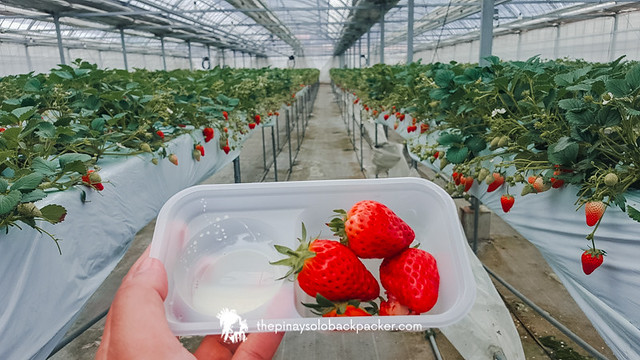
Suwako Ichi-goen (Suwako Strawberry Farm)
Location: Toyoda, Suwa-shi, Nagano
Open Hours: Daily 10:00 AM – 3:00 PM
Entrance Fee: ¥800 (₱375- $7 – SGD 10 – MYR 30 ) to ¥1,700 (₱798- $15 – SGD 21 – MYR 64)
How to get to Suwa Strawberry Farm the Suwako Ichigo-en: From Shimosuwa Station or Kamisuwa Station Suwako Exit (West), you can take the Swan Bus or Karin-chan Bus for approximately 20 minutes. Alight at Suwa Garasu No Sato. Fare is ¥150 (₱70- $1.35) for adults and ¥80 (₱38- $0.72) for children. You can check the Swan Bus timetable HERE. From the Suwa Garasu No Sato Bus Stop, walk for about 5 minutes to the Suwa Strawberry Farm. Use Google Maps for walking directions.
7.MUSIC BOX MUSEUM
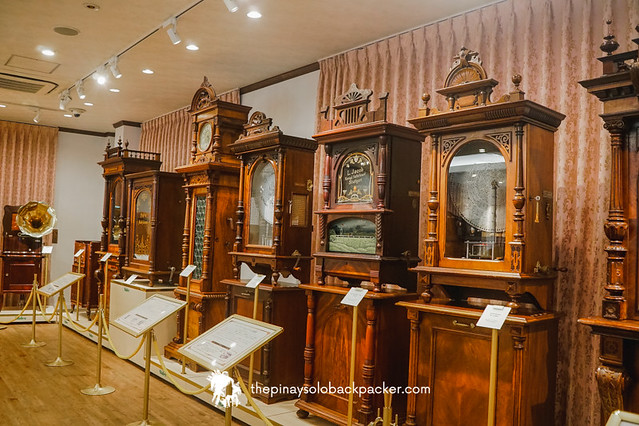
Another unique tourist destination in Suwa, Nagano that we visited was the Nidec Sankyo Corporation Music Box Memorial Suwanone, the largest manufacturer of music boxes. Established in 1946 and formerly known as Sankyo Seiki, the Nidec Sankyo Corporation started developing music box in 1948 and where able to ship their first 500 music boxes. Currently, the company owns about 90 antique music boxes from Switzerland, Germany, etc. Luckily, I got to see some of them displayed at the World Music Box and Concert Hall on the 2nd floor of the Music Box Museum. We were able to listen to some of the age-old music boxes displayed there while listening to its history and structure of each music box during the guided tour.

We were also able to watch a performance entitled “Rose’s Mysterious World Trip”, a combination of live music box show with actors and videos at the Concert Hall. Rose was performed by Mayu Sophia, a reporter and radio DJ who appeared in the movie “Sakura Kita”.
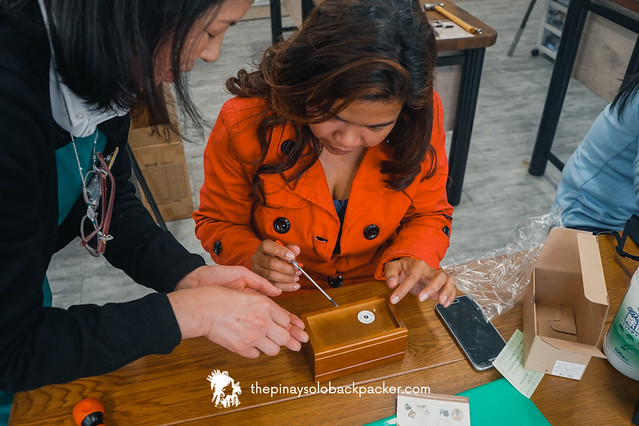
But perhaps my most memorable experience here is the short workshop for making music boxes. They asked us to choose a music for our music box as well as the design that we like in advance before we paid them a visit. As soon as we arrived, we were whisked away to the workshop center and started making our own music box with their assistance. It was quite easy and I find it interesting that we can actually chose how fast or slow we want our music. I picked “Silent Night” as music because I don’t know what to choose. But I wanted to give it to my mother as present since I remember she really likes to have a music box. Indeed, she was so happy when she got it. I bought one for myself at the souvenir shop, and I regret that I only got one, I wish I had bought more since the price is reasonable. Some music boxes are as low as $15. It’s a lovely gift for your friends and loved ones. Oh well, a reason to return here when I revisit Nagano in autumn.
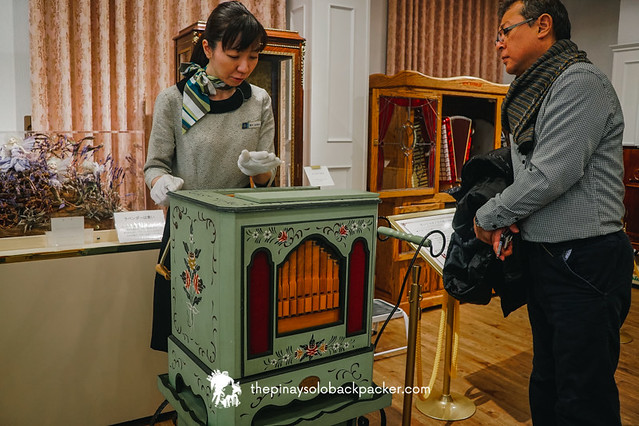
Nidec Sankyo Corporation Music Box Memorial Suwanone
Location: 5805, Kamikubo, Shimosuwa-machi, Suwa-gun, Nagano
Open Hours: Daily except Sundays and public holidays 9:00 AM – 5:30 PM
Entrance Fee (World Music Box and Concert Hall) : ¥1,000 (₱469- $9 – SGD 12 – MYR 37 )
How to get to Nidec Sankyo Corporation Music Box Memorial Suwane: From Shimo-suwa Station (JR Line), it’s about a 10-minute walk. Walk north to the Taisha Odori Road (Route 20) and turn right.
TAKASHIMA CASTLE RUINS
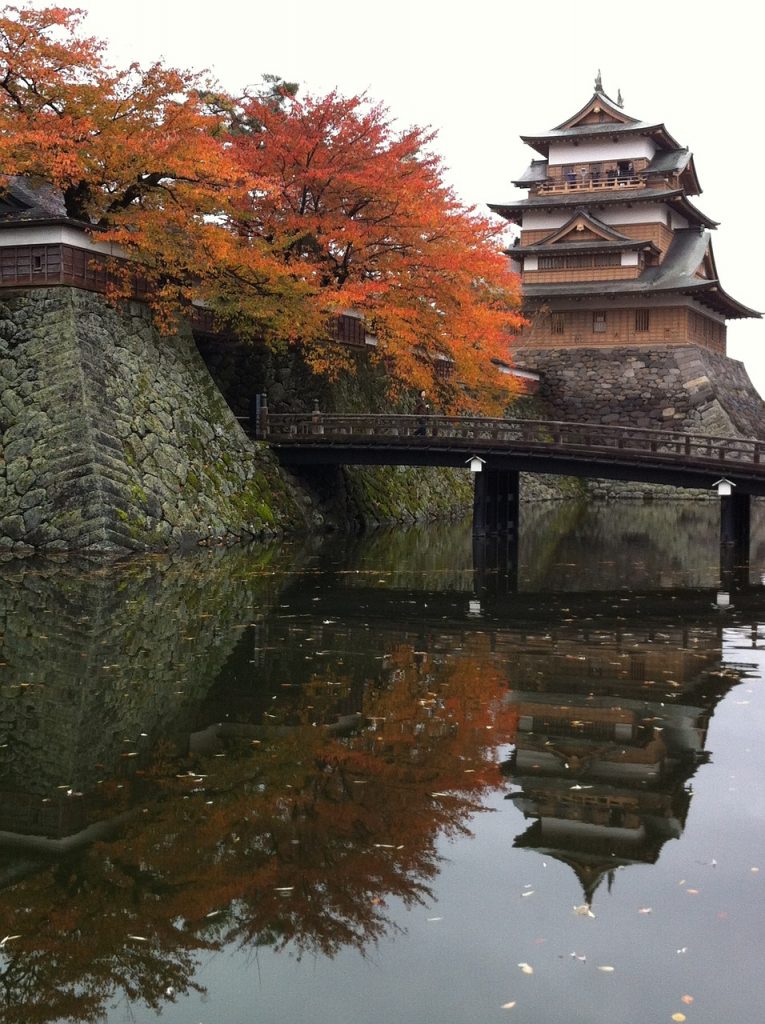
Image by Kizuna
Takashima Castle
Location: 1-20-1 Takashima, Suwa-shi, Nagano-ken 392-0022
Open Hours: Daily from 09:00 AM – 5:30 PM, 09:00 AM – 4:30 PM from Oct 1 – March 31.
Closed on Dec 26-31 and 2nd Thurs in November
Entrance Fee: ¥300 (₱141 – $3 – SGD 4– MYR 11) (adults) , ¥150 (₱71 – $1.36 – SGD 2 – MYR 6) (adults)
How to get to Takashima Castle:
1.Take the JR Chou Line to Kami-Suwa Station.
2.Get off at Kami-Suwa Station and take the Suwako Exit.
3.Walk to Takashima Castle for about 10 minutes.
SUWA SIDE TRIPS, ALSO READ:
MATSUMOTO ITINERARY
ZENKOJI TEMPLE
HAKUBA ITINERARY
LAKE SUWA ITINERARY
Here’s a suggested 2-day 1-night itinerary of Suwa, Nagano. It can also be done as a day trip if you want, but I’d still recommend at least a 2 day stay here to cover the Suwa top tourist attractions listed above.

*hotel, airfare, and shopping not included.
2 DAYS SUWA ITINERARY
| DAY 1 | ARRIVAL + SUWA TAISHA SHRINE + ONSEN |
| 07:00 AM | ETD Suwa |
| From JR Shinjuku Station in Tokyo, take Limited Express Train | |
| Azusa to Kami-Suwa Station. 2.5 hours. ¥5,870 (₱ 2,758 – $53). FREE w/ JR Pass | |
| 09:13 AM | Alight at Kami-Suwa Station Suwako Exit |
| 09:20 AM | Take shuttle to hotel (Rako Hananoi Hotel). RESERVE HERE |
| Shuttle bus reservation HERE (Click translate to English on the upper right hand of the site) | |
| Leave luggage at concierge | |
| 09:40 AM | Walk to Takashima Castle. 12 mins. Google Maps directions HERE. |
| 09:55 AM | Takashima Castle. ¥300 (₱141 – $3) |
| 11:30 AM | Walk to Kami-Suwa Station. Google Maps directions HERE. 13 mins. |
| At Kami-Suwa Station, take JR Chou Line for Nagano or Matsumoto. | |
| Alight at Okaya Station. 9 mins. ¥200 (₱ 94 – $1.8) FREE w/ JR Pass | |
| 11:45 AM | Walk to Tenryuu House of Unagi. 11 mins. Google Maps directions HERE. |
| 12:10 PM | Unagidon lunch. ¥3,000 (₱ 1,409 – $27) |
| 01:10 PM | Walk back to Okaya Station. 12 mins. Google Maps directions HERE. |
| 01:25 PM | Take JR Chou Line for Takao or Kofu, or Limited Express Azusa. |
| 01:45 PM | Alight at JR Chino Station. 19 mins. ¥320 (₱150 – $2.89) FREE w/ JR Pass |
| 02:20 PM | From JR Chino Station, take the Suwa bus bound for Okuma |
| Get off at Maemiya-mae bus stop. 7 mins. | |
| 02:35 PM | Suwa Taisha Shrine – Upper Shrines. |
| Maemiya Shrine and Honmiya Shrine. FREE | |
| 04:00 PM | Take bus to JR Chino Station. 7 mins. |
| Alight at JR Chino Station. 19 mins. ¥320 (₱150 – $2.89) FREE w/ JR Pass | |
| Take the JR Chou Line for Nagano | |
| Alight at Shimo-Suwa Station. | |
| Walk to Suwa Taisha Lower Shrines. 15 minutes. | |
| Harumiya Shrine and Akimiya Shrine | |
| 05:30 PM | Walk back to Shimo-Suwa Station. 15 minutes |
| 05:45 PM | At Shimo-Suwa Station, take JR Chou Line for Chino, Takao, or Kofu. |
| Alternatively, you can take the Limited Express Azusa | |
| 05:55 PM | Alight at Kami-Suwa Station. 5 mins. ¥190 (₱89– $1.72) FREE w/ JR Pass |
| 06:00 PM | Early dinner. ¥1,000 (₱ 469 – $9) |
| 06:30 PM | Walk or take shuttle to hotel. |
| 06:50 PM | Hotel check-in. Freshen up. |
| 08:00 PM | Sleep |
| Day 1 Expenses | ¥11,200 (₱ 5,260 – $10.19 – SGD 139 – MYR 422 ) |
| DAY 2 | |
| 07:00 AM | Check-out. Leave luggage at hotel. Walk to Lake Suwa |
| 07:15 AM | Lake Suwa. FREE |
| 08:00 AM | Try the cricket ice cream. ¥450 (₱211- $4) |
| 08:15 AM | Walk to Kami-Suwa Station. 11 minutes. |
| Take the Swan Bus or Karin-chan Bus. | |
| 08:50 AM | Alight at Suwa Garasu No Sato bus stop. 20 mins. ¥150 (₱70- $1.35) |
| Walk to Suwa Garasu No Sato | |
| 08:55 AM | Suwa Garasu No Sato. ¥800 (₱ 375- $7) |
| 10:55 PM | Walk to Suwako Ichi-goen (Suwako Strawberry Farm). 5 mins. |
| 11:00 PM | Suwako Ichi-goen (Suwako Strawberry Farm). ¥800 (₱375- $7) |
| 11:15 PM | Walk back to Suwa Garasu No Sato bus stop |
| Take the Swan Bus to Kami-Suwa Station. 20 mins. ¥150 (₱70- $1.35) | |
| 11:50 PM | Alight at Kami-Suwa Station. |
| 12:00 PM | Take the JR Chou Line to Matsumoto, Nagano, or Inafukuoka |
| 12:10 PM | Alight at Shimo-Suwa Station. 4 mins. ¥190 (₱89– $1.72) |
| 12:20 PM | Walk north to the Taisha Odori Road (Route 20) and turn right. 10 mins. |
| 12:40 PM | Nidec Sankyo Corp. Music Box Memorial. ¥1,000 (₱469- $9) |
| 02:00 PM | Walk back to Shimo-Suwa Station. |
| 02:20 PM | Take the JR Chou Line for Takao, Kofu or Chino. 4 mins. ¥190 (₱89– $1.72) |
| 02:30 PM | Alight at Kami-Suwa Station. |
| 02:35 PM | Walk back to hotel. |
| 02:50 PM | Get luggage. Walk back or take shuttle to Kami-Suwa Station. |
| Proceed to next destination. | |
| Day 2 Expenses | ¥3,730 (₱1,748 – $33.14 – SGD 46 – MYR 140 ) |
| TOTAL EXPENSES | ¥14,930 (₱7,008– $43.33 – SGD 184 – MYR 562 ) |
*Cover photo provided by Nagano Tourism
DISCLOSURE: My Nagano trip was made possible by Nagano Tourism.

Special thanks to Suwa Tourism Board for all the help.
JAPAN SERIES:
JAPAN VISA FOR PHILIPPINE PASSPORT HOLDERS
HAKUBA TRAVEL GUIDE
MATSUMOTO TRAVEL GUIDE (ITINERARY + BUDGET)
SUWA TRAVEL GUIDE
NAGOYA TRAVEL GUIDE
OSAKA TRAVEL GUIDE
KYOTO TRAVEL GUIDE
NARA TRAVEL GUIDE
TOKYO ITINERARY
SAPPORO TRAVEL GUIDE
About the Blogger : Gael is a Filipina travel blogger. Her work has appeared in local and international publications.
Follow her on [wp-svg-icons icon=”facebook-2″ wrap=”i”] Facebook , [wp-svg-icons icon=”twitter” wrap=”i”] Twitter and [wp-svg-icons icon=”instagram” wrap=”i”] Instagram.
For advertisements, sponsorship and partnerships, you may reach her at gaelhilotinblog (at) gmail (dot) com.
LIKE MY PAGE ON FACEBOOK FOR TRAVEL GUIDE UPDATES
FOLLOW ME ON INSTAGRAM
Watch my latest [wp-svg-icons icon=”youtube” wrap=”i”] Youtube video.
Don’t forget to click [wp-svg-icons icon=”point-right” wrap=”i”] SUBSCRIBE HERE

